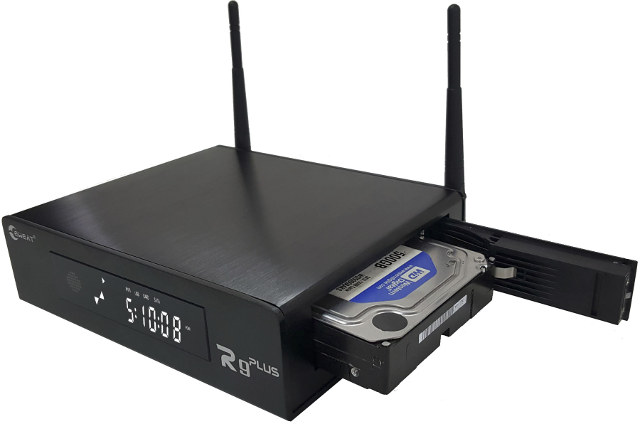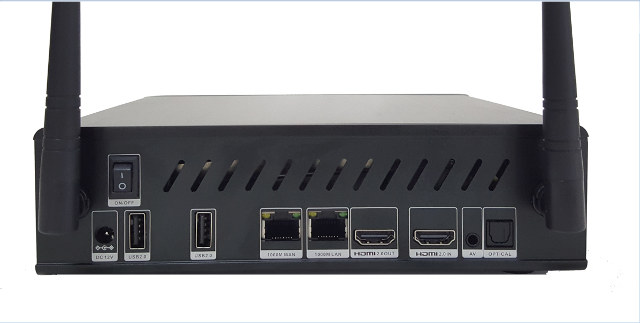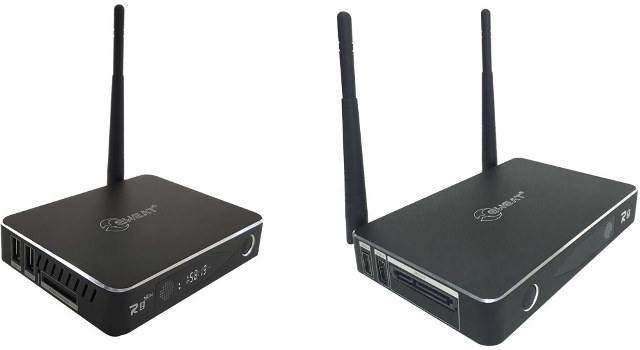Eweat has now introduced three TV box models based on Realtek RTD1295 64-bit processor with Eweat R9, Eweat R9 mini, and Eweat R9 Plus, bringing some competition to the upcoming Zidoo X9s TV box, with respectively an external SATA port, no SATA, and an internal SATA bay.

All three devices share most of the same specifications:
- SoC – Realtek RTD1295 quad core Cortex A53 processor with ARM Mali-T820 MP3 GPU
- System Memory – 2GB DDR3
- Storage
- R9 Mini – 8 GB eMMC + SD card reader
- R9 – 16 GB eMMC + SATA 3.5 connector for external drive + SD card reader
- R9 Plus – 16 GB eMMC + internal 3.5″ SATA 3.0 bay + SD card reader
- Video I/O – HDMI 2.0a output, HDMI 2.0 input, and AV
- Audio I/O – HDMI, AV, optical S/PDIF output
- Video Playback – HDR, 10-bit HEVC/H.265 up to 4K @ 60fps, H.264 up to 4K @ 60 fps, VP9 up to 4K @ 60 fps, BDISO/MKV, etc… automatic frame rate switching
- Audio Features – 7.1 channel audio pass-through for Dolby TrueHD, DTS-HD MA, LPCM, Dolby Digital Plus
- Connectivity
- R9 mini – 1x Gigabit Ethernet, dual band 802.11 b/g/n WiFi and Bluetooth 4.0 with one external antenna
- R9 and R9 Plus – 2x Gigabit Ethernet, dual band 802.11 b/g/n/ac WiFi and Bluetooth 4.0 with two external antennas
- USB
- R9 mini – 1x USB 3.0, 1x USB 2.0 host port
- R9 and R9 Plus – 1x USB 3.0, 2x USB 2.0 ports
- Misc – Power switch, LCD display on front panel
- Power Supply
- R9 mini – 5V/2A
- R9- 12V /2A
- R9 Plus – 12V/2.5A
- Dimensions& Weight
- R9 mini – 130 x 100 x 23 mm; 500 grams
- R9 – 170 x 115 x 24.5 mm; 1 kg
- R9 Plus – 200 x 143 x 55 mm; 1.8 kg

The three devices will run Android 6.0 with a custom version of Kodi 16, as well as OpenWrt (TBS), and ship with accessories such as a IR remote control (optional air mouse), HDMI and AV cables, a power adapter, quick installation guide, and a warranty card. HDMI input can be used for PiP (picture-in-picture) and to record video from game console, set-top boxes, computers, and so on, but I could not confirm the maximum resolution, but if it works like on Zidoo X9s, it will support HDMI video recording and streaming up to 1080p60 resolution. 4K recording won’t be supported despite the HDMI 2.0 input interface.

The company told me the hardware is now complete, but software is still work in progress, with mass production scheduled for mid-summer, i.e. end of July, beginning of August, and pricing not available yet. More information should eventually surface on EWEAT website.
Via AndroidPC.es

Jean-Luc started CNX Software in 2010 as a part-time endeavor, before quitting his job as a software engineering manager, and starting to write daily news, and reviews full time later in 2011.
Support CNX Software! Donate via cryptocurrencies, become a Patron on Patreon, or purchase goods on Amazon or Aliexpress





All manufacturers that make/sell players based on Realtek RTD1295 (as well as Realtek themselves) violate the GPL open source license that Kodi is bound under by not releasing the full source code of the custom video player have Realtek have integrated into Kodi to achieve hardware accelerated decoding on Realtek SoCs.
You can compare this with the custom video player in Kodi for Amlogic SoCs which have the full source code release so does not violate the GPL. I don’t see why Realtek would not just release that code, there should not be any secrets in that code, and releasing it could be benificial to all products using Kodi if any of the code modifications are good enough to be implemented upstream into the official Kodi master.
An alternative for when using Android OS (but not Linux) is that they write codecs for Android’s MediaCodec API, then they would not have to have to have to make any customizations to Kodi at all as Android’s MediaCodec API acts as a middleware translating the requests to the codecs.
EWEAT R9 is now sold on Aliexpress for $104.49 – http://www.aliexpress.com/store/product/Newest-Eweat-R9-Mini-Android-6-0-TV-BOX-Realtek-1295-Cortex-A53-Mali-T820-Quad/1255069_32710128478.html